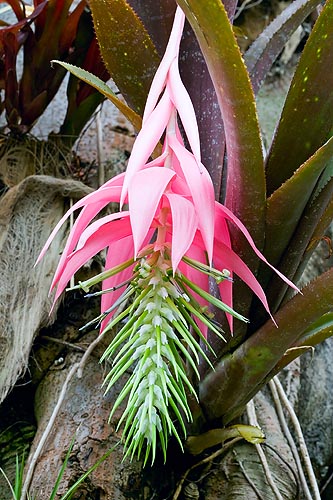Family : Bromeliaceae

Text © Pietro Puccio

English translation by Mario Beltramini

One of the most showy and imposing Billbergia © Mazza
The genus is honoured to the Swedish botanist Gustav Johann Billeberg (1772-1844); the Latin name of the species “rosea” = pink, refers to the colour of its bracts.
Common names: “flor de junio”, “parasite de San Juan” (Spanish).
Evergreen herbaceous plant, monocarpic (it bears fruit but once, then dyes), acaulescent, epiphytic, with few leaves, up to 90 cm long and 10 cm broad, placed in such a way to form a long cylinder; the leaves, of a more or less bronze colour, with horizontal silvery grey stripes, have the margins furnished of thick, 1-3 mm long, thorns.
The flowers are assembled in a hanging paniculate inflorescence, with a powdery white stem, surrounded by showy pink lanceolate-ovate bracts; the single flowers are about 9 cm long with a floury white ovary and sharp, about 7 cm long, petals, of a yellowish green colour rounded backwards, which are followed by globose yellow fruits of about 1 cm of diameter.
It propagates by seed and by division of the new vegetations which are produced laterally, on an average of three per year, and which take four to five years for blossoming. The plant is considered as the most ornamental of the genus and also one of the biggest, and can be cultivated in open spaces in very luminous position in the tropical and humid subtropical zones, even is it is able to stand long periods of drought.
For what the temperature is concerned, it can stand, for a very short period and in a dry place, temperatures close to the 0°C. When in pot, it is very much appreciated for luminous indoors decorations, verandas and winter gardens with temperatures which is good to be kept over the 14 °C, better around 18-22°C, utilizing a very draining substratum, which can be formed by peat and sand or other inert materials (agri-perlite, vermiculite, etc.), kept slightly humid, and with some water at the centre of the rosette is the temperatures are over the 16-18°C; with lower temperatures, there is the risk of formation of rottenness.
The ambient humidity, when in presence of dry air and high temperatures, can be, if necessary, increased through nebulisations, utilizing water at room temperature and not calcareous, in order to avoid un-aesthetic dots on the leaves.
Synonyms: Billbergia granulosa Brongn. (1860); Billbergia venezuelana Mez (1921).
→ For general notions about BROMELIACEAE please click here.
